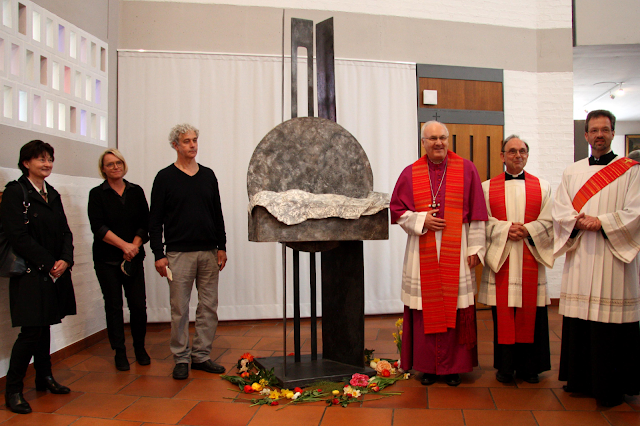Modernist version of Holy Sepulchre. An abstraction of the Faith.
Cross gives life meaning and purpose
Bishop Dr. Rudolf Voderholzer blessed a new Holy Sepulchre in the Parish church of St. Pius in Landshut on Good Friday afternoon. He spoke of the ancient tradition of the Holy Sepulchre in the churches and thanked the parish for the creative realisation. The new Holy Sepulchre takes up the formal language of the modern church consecrated in 1963. In a lengthy process, the artists Hanna Regina Uber and Robert Diem created the bronze sculpture in close consultation with the city's parish priest Alfred Wölfl, those responsible for the parish and those responsible for art in the diocese. The artist couple worked on the work in their own studio in Aschach near Amberg for a good six months. A couple from the parish, who do not wish to be named, donated this sculpture of the Holy Sepulchre. Father Wölfl and the parish received the gift with gratitude and joy.
Children participate in the Stations of the Cross
Before the blessing, the bishop prayed the Stations of the Cross outdoors with the parish community. "Jesus has taken suffering and death upon himself, we want to ask him for refuge. We receive comfort and confidence from our Lord Jesus Christ". He took with him on his way the sufferings of the terrible war, the displaced persons and the multiple hardships of the people. At the main entrance of the church, palm bouquets, donkeys, crowns, banners and texts of the children reminded of Palm Sunday. From here the procession formed to follow Jesus' way of suffering. First stop at the church tower. Jesus is condemned to death and takes the cross on his shoulders. The Bishop prayed with Father Alfred Wölfl and the children. At the second station, everyone is asked to take a stone from the container. It reminds them of their own burden, of evil words. Jesus falls under the cross, the cross is heavy, Jesus collapses. Third station, Simon of Cyrene helps Jesus. He has hands that grasp, compassion and courage. Everyone needs a helping hand and can do good to others. The next station on the church wall - pictures of accidents, wars, natural disasters. The Cross carried by the children is put up. There are so many crosses to carry, Jesus my hope, my joy. Last station in the church. Jesus is laid in the tomb. We are afraid of death, but it is not the end, God does not let us fall. Many people lay flowers, so that the Holy Sepulchre can be decorated.
Blessing of the bronze sculpture
Moved by the impressive stations of the Stations of the Cross, everyone gathered in front of the new Holy Sepulchre. The Bishop said the prayer of blessing over the sculpture. "The cross has become a sign of victory. It gives meaning and purpose to our lives. In this Holy Sepulchre we can experience something of this mystery." The contemporary depiction aims to bring the meaning of the event home to the viewer. The event is not depicted figuratively, it can only be guessed at. Artist Hanna Regina Uber revealed the spiritual and artistic position. The hewn scroll stone stands as a symbol of worldly power with the attempt to rule by force. Coarse, rough, rigid, heavy and cold, it forms the contrast to the cloth. This covers the hidden Christ. As a symbol of compassion, it lies soft, comforting and light. The bronze sculpture accompanies the resurrection of Jesus. Two successive depictions testify to the transformation. The first image shows the body of Jesus covered by a burial shroud in a closed tomb on Good Friday. On the Easter Vigil, the folded shroud and the opening in the scroll point to the resurrection in the altered depiction. It is depicted as a force that penetrates. The stone opens, violence is overcome from death to life. The light of hope shines - Easter.
Dr Maria Baumann, the artist couple Robert Diem and Hanna Regina Uber, Bishop Rudolf Voderholzer, Parish Priest Alfred Wölfl and Deacon Johannes Faltermeier in front of the new sculpture.
As it says above, in keeping with the rest of the Church.
Compare a proper Holy Sepulchre as can be found in many Bavarian churches.
The latest contemporary sculpture of a Holy Sepulchre
At a grave, the finiteness of earthly life becomes conscious, said Dr Maria Baumann, curator of the Diocese of Regensburg. The question of what comes after death comes very close. Burial sites are an important testimony of past cultures, also of ideas about death. "The Holy Sepulchre remains the desire to represent that which cannot be represented". There are hardly any contemporary works from the 20th century. The work of Hanna Regina Uber and Robert Diem is now all the more extraordinary in contemporary sacred art. "It places the place where Easter happens in 2022 as an open symbol in all the challenges of today, before which we stand with many thoughts and feelings. And it conveys the still valid message: Christ is risen".
Cathcon: Increasingly people have no religious background and would not have a clue what they are looking at. Images speak like words. This is dumb.











.jpeg)

Comments